Take 10 With a Triton: Roger Hailstork Returns to the Bookstore With a Focus on Accessibility
Profiles
Research Vessel Roger Revelle
The research vessel Roger Revelle, owned by the U.S. Navy's Office of Naval Research and operated by Scripps Institution of Oceanography at UC San Diego, returns to San Diego after a six-year deployment.
Roger Revelle (1909-1991), the ship's namesake, was director of Scripps Institution of Oceanography from 1951 to 1964. Long associated with the University of California, Revelle's vision and energies led to the establishment of the UC San Diego campus in 1960.
"It is wonderfully appropriate that the research vessel named in honor of Roger Revelle, the founder of this great campus, returns home on the occasion of UC San Diego's Founders' Day. This homecoming follows six years of exploration and is a prime example of the amazing work and research of our campus members over the last five decades," said UC San Diego Chancellor Pradeep K. Khosla.
The research vessel was named for Roger Revelle by the U.S. Navy to honor his extraordinary scientific contributions. He was one of the nation's most prominent oceanographers, a pioneer of climate change research and a world leader in the application of science and technology to help solve problems in developing countries.
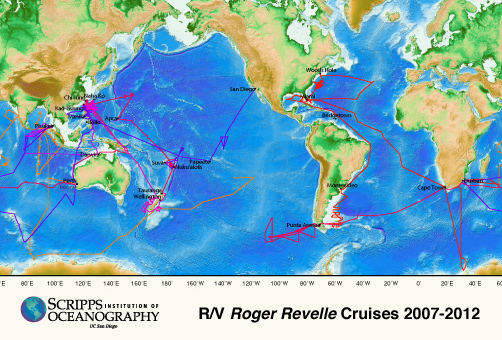
During its six-year-deployment, R/V Roger Revelle traveled to ports spanning the eastern U.S. seaboard and internationally to Samoa, New Zealand, Australia, Indonesia, Mauritius, Seychelles, South Africa, Uruguay, Chile, Taiwan, Guam, Tonga, Fiji, Japan, Thailand, Philippines, Vietnam, and French Polynesia, among others.
"R/V Roger Revelle is the premier vessel in the Scripps Institution of Oceanography academic fleet. We welcome her home and applaud her captain, crew and ship operations for six years of superior support of sea-based science," said Cathy Constable, acting director of Scripps. "We look forward to the ship's return to sea and new expeditions that address vital concerns for science and society."
"Since departing from its home port in Point Loma on Dec. 1, 2006, R/V Roger Revelle has conducted 86 missions in many parts of the western Pacific. It has been seen in numerous countries and hosted many U.S. and foreign scientists. The science enabled by this ship's voyage is contributing new knowledge about the oceans and atmosphere, and will open many additional avenues of research. Our Navy is pleased to have such ships to use and share among federal agencies," Dr. Frank Herr, head of the Ocean Battlespace Sensing Department at the Office of Naval Research.
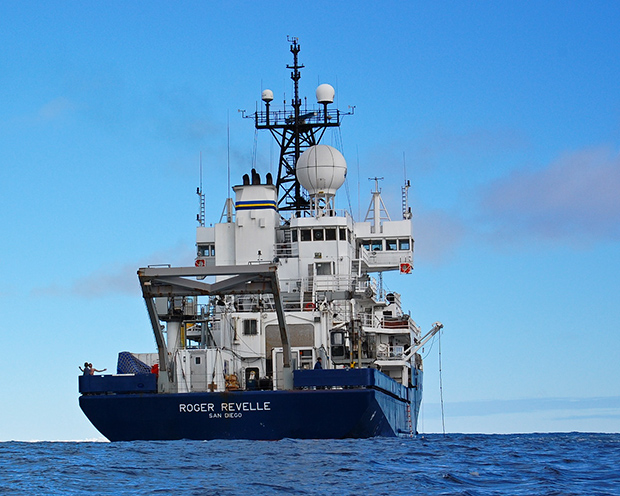
R/V Roger Revelle during a 2009 expedition. Credit Brett Longworth
The 273-foot ship's scientific missions involved explorations from the deepest parts of the ocean's remote trenches to the upper atmosphere, covering topics relevant to society and of significance to the U.S. Navy and national security.
Research projects covered a broad mix of science, including projects related to global climate, ocean acidification, plate tectonics, volcanic processes, resource exploration, ecosystem dynamics, marine mammals, ocean waves and currents and ocean acoustics.
Earlier this year Scripps scientists and ship operations crews visited Vietnam for a series of ship tours and classes with Vietnamese scientists. That goodwill visit paved the way for physical oceanography expeditions planned off Vietnam in 2013, leading to the establishment of new scientific collaboration between oceanographers from the two countries since the Vietnam War.
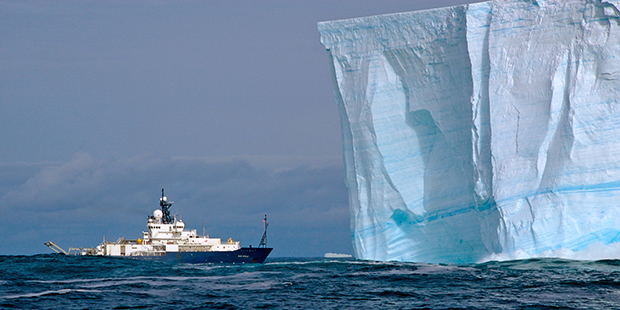
In 2007, R/V Roger Revelle explored the seas off Antarctica. Credit: Paul Mauricio
Before heading out of San Diego on an ambitious science support schedule next year, R/V Roger Revelle, launched in 1996, will undergo routine maintenance at a West Coast shipyard. Additionally, in San Diego, nearly $300,000 will be spent at local maritime businesses on Roger Revelle upkeep operations and maintenance.
"Welcome home Scripps vessel Roger Revelle-the importance of home porting in San Diego one of largest academic research fleets in the world is immense-ranging from the scientific achievements and worldwide recognition to the economic impact. Over the next couple of months many hundreds of thousands of dollars will be spent on maintenance and provisioning of Revelle, all of which supports San Diego service providers and businesses. We are proud to be able to help recognize the extraordinary regional significance of Scripps and its fleet!" said Michael Jones, president of The Maritime Alliance.
As with the other research vessels it operates, Scripps is continually seeking to improve its ships and their operational value. To that end, R/V Roger Revelle will be outfitted with a first-of-its-kind robotic arm for deploying ocean water sampling equipment. The robotic arm, more properly known as a "scientific load handling system," is designed to enable over-the-side operations in conditions that are rougher than allowed by existing systems, and therefore enable Roger Revelle to work more efficiently in harsh conditions. The system is also designed to better protect the expensive instrumentation from damage, which improves reliability and lowers the overall cost of operations. The system will be operable by a single person using remote-control, rather than a team of four to five handlers presently required. All of these factors are aimed at improving efficiency and safety at sea.
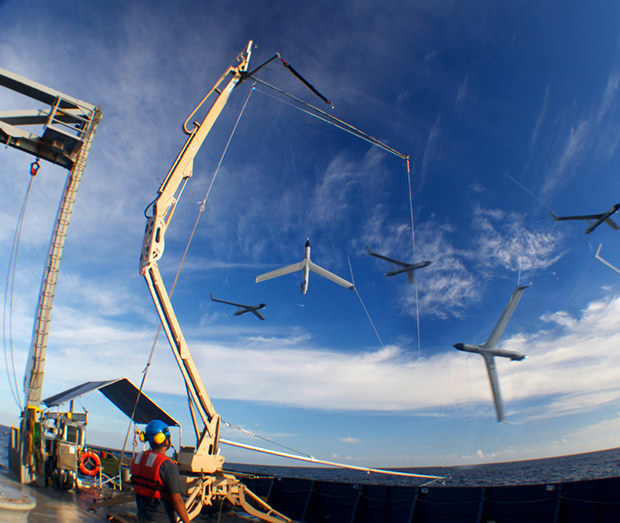
Researchers led by Scripps oceanographer Ken Melville study air-sea interactions with unmanned aircraft launched from R/V Revelle.
"Bringing a system like this up to operational status is a difficult job, requiring technical skill and a deep understanding of how mechanical and electronics systems work aboard hostile environments at sea," said Bruce Appelgate, Scripps Institution of Oceanography associate director. "Scripps marine technicians and mariners have the level of expertise needed to successfully integrate this system into our routine operations. Our goal is to improve the observing capabilities of scientists aboard Roger Revelle, and also to share our results with other ships in the U.S. academic research fleet that can benefit as well from our advances."
The Scripps fleet, one of the largest academic fleets in the United States, conducts scientific operations around the planet, including missions that support the U.S. Navy and national security interests. The fleet includes the research vessels Roger Revelle, Melville, New Horizon, and Robert Gordon Sproul.
In 2015 Scripps will begin operating AGOR 28, a new "ocean class" research vessel. Designed to operate globally, this vessel will support both U.S. Navy and national oceanographic research objectives (http://sio.ucsd.edu/Announcements/AGOR28_Keel_Laying/).
AGOR 28 will become a resource for the innovative UC Ship Funds Program, which offers students unique leadership opportunities at sea and supports the development of the next generation of scientists (http://shipsked.ucsd.edu/General_Info/UC_Ship_Funds/index.php).
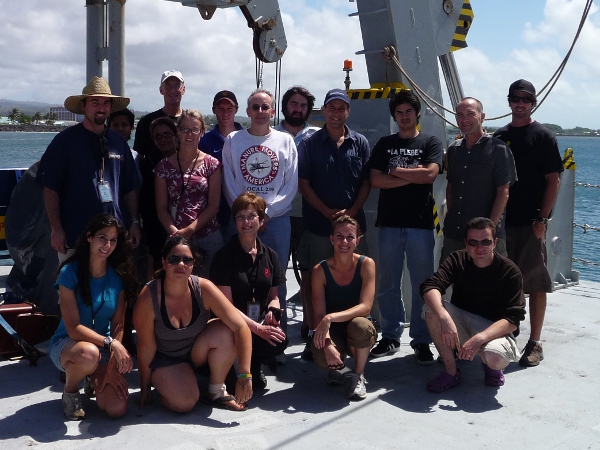
A UC Ship Funds Program cruise led by Scripps graduate student Rosa Leon Zayas explored the deep sea of the Tonga Trench.
"The experience of being the chief scientist of a research expedition was an enriching experience, full of struggles and rewards," said Rosa Leon Zayas, a Scripps graduate student and chief scientist of the recent Tonga Trench Expedition that explored the deep-sea environment and was supported by the UC Ship Funds Program.
Thousands of scientists, students and government researchers conduct missions aboard Scripps research vessels every year, making them the most widely used oceanographic vessels in the United States. Scripps operates one-fifth of the research vessels in the U.S. academic research fleet. Funded operational days for Scripps ships in 2012 will account for 22 percent of the fleet's capacity.
From Jan. 1, 2009, to July 31, 2012, Scripps ships carried nearly 4,200 people to sea. About one-quarter of Scripps ship users are from other U.S. academic institutions, with the remainder made up of academic and government researchers sponsored by the Office of Naval Research, NOAA, other government agencies, international researchers, K-12 educators and privately sponsored researchers. Scripps has operated research vessels since 1904, and is a charter member of the University-National Oceanographic Laboratory System (UNOLS), which coordinates fleet activities.
Keep up with all the latest from UC San Diego. Subscribe to the newsletter today.